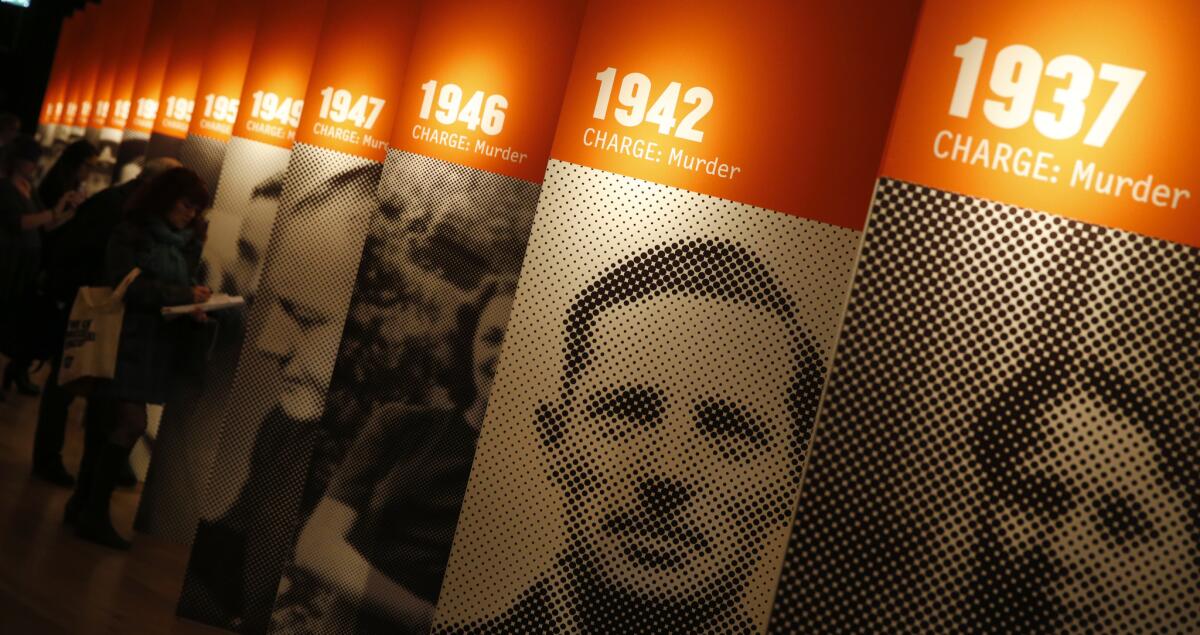In this startling London museum exhibit, murder and mayhem take center stage

Members of the media look at exhibits during a preview of the Crime Museum Uncovered exhibition at the Museum of London on Oct. 7
- Share via
As Big Ben chimed, a familiar voice intoned these words: “The Black Museum… Here in the grim stone structure on the Thames which houses Scotland Yard is a warehouse of homicide.”
The objects inside, the honeyed voice continues, “all were touched by murder.”
The voice is that of Orson Welles, “speaking from London.” That radio show from the 1950s, called “The Black Museum,” was probably as close as most of us ever got to objects “touched by murder.”
Now, a new exhibit at the Museum of London, called the Crime Museum Uncovered, gives you a close-up look at instruments of evil from New Scotland Yard’s repository of crime. Its nickname was the Black Museum.
Unless you were a police professional or, perhaps, Harry Houdini, Stan Laurel and Oliver Hardy, Sir Arthur Conan Doyle or King George V — all select guests — you could until now only wonder what was housed in the Black Museum.
But what was off-limits to most of us has become public, thanks to the sale last year of the New Scotland Yard building that housed the objects.
Now they are taking center stage, arrestingly and chillingly, with the exhibit set to run through April 10.
The exhibit is split into two periods.
The first section runs up to 1905, the year an early use of fingerprint evidence convicted Albert and Alfred Stratton of murder, and highlights death masks, nooses from Newgate Prison, courtroom illustrations, the gun used to shoot at Queen Victoria in 1842, a cat burglar’s folding ladder, startlingly personal items such as a murderer’s snuff box or violin and, yes, some Jack the Ripper material.
The larger section deals with more contemporary events and much of what London’s Metropolitan Police force has faced since then.
Displays cover drugs, robbery, counterfeiting, espionage, firearms, terrorism, a nasty collection of modified weapons (including binoculars with spring-loaded spikes) and even an “Execution Box,” a trunk containing everything you needed to carry out an execution.
It’s the roll call of murderers, though, that inevitably catches the eye.
The cases often show the evidence that gave them away, and, of course, their weapons of choice.
From the domestically familiar flypaper to a kitchen knife to guns, gloves and a gas mask used when dissolving bodies in acid, they were purposely selected because each case dealt with an advance in criminal detection such as ballistics, fingerprinting or crime scene photos.
Famous names will jump out at you.
The Krays, twins Ronnie and Reggie, who terrorized the East End in the 1950s and '60s and were subject of a 1990 film called, not surprisingly, “The Krays.” John George Haigh, the Acid Bath Murderer. John Christie, a serial killer from the ’40s and '50s who strangled at least eight people. Ruth Ellis, hanged for the killing of David Blakely, her lover.
But it's the names and crimes long-forgotten that pack the most punch, including the 1924 murder of the pregnant Emily Kaye, whose bigamist boyfriend, Patrick Mahon, chopped her into pieces.
He was convicted and sentenced to death, and someone sneaked a picture of Mahon taken at the moment sentence was imposed. That picture is here too.
The end of the exhibit includes a series of short films titled “Reflections” that discuss the public fascination with crime and the debates and ideas related to what you have just seen; it’s a thoughtful and sobering reminder that these crimes really happened, and that the victims were real people.
Info: Reservations to the Museum of London exhibit are suggested because of its popularity. Admission is 10 pounds, about $15.50.
MORE
Virginia City, Nev., toasts Halloween with a new spirit, whose creepy name is part of mining lore
What's scarier than "The Shining" hotel in Colorado? "The Shining" hotel with a horror museum
The 10 creepiest Halloween haunts in the U.S.: Where to scare yourself silly
Follow us on Twitter at @latimestravel
Sign up for The Wild
We’ll help you find the best places to hike, bike and run, as well as the perfect silent spots for meditation and yoga.
You may occasionally receive promotional content from the Los Angeles Times.



